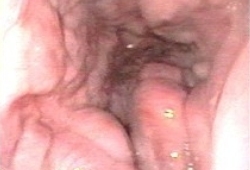Summary
Definition
History and exam
Key diagnostic factors
- cirrhosis
- severe liver disease
- alcohol misuse
- hepatitis B or C infection
- ascites
- spider angioma
- caput medusa
- jaundice
- encephalopathy
- hematemesis
- melena
- hematochezia
- HIV coinfection
Other diagnostic factors
- splenomegaly
Risk factors
- portal hypertension
- size of varices
- red wale marks
- decompensated cirrhosis
- ascites
Diagnostic tests
1st tests to order
- hepatic venous pressure gradient (HPVG)
- complete blood count
- coagulation profile (INR/prothrombin time)
- serum LFTs
- BUN and creatinine
- blood typing/cross-matching
- hepatitis B surface antigen (HBsAg)
- anti-hepatitis C virus IgG (anti-HCV IgG)
- esophago-gastro-duodenoscopy (EGD)
- liver stiffness measurement (LSM)
Emerging tests
- capsule endoscopy
Treatment algorithm
decompensated cirrhosis with acute variceal hemorrhage (hepatic venous pressure gradient ≥10 mmHg)
decompensated cirrhosis with acute variceal hemorrhage and failed endoscopic/pharmacologic therapy
compensated cirrhosis with mild portal hypertension (hepatic venous pressure gradient >5 and <10 mmHg)
compensated cirrhosis with clinically significant portal hypertension (hepatic venous pressure gradient ≥10 mmHg): without gastroesophageal varices
compensated cirrhosis with clinically significant portal hypertension (hepatic venous pressure gradient ≥10 mmHg): with gastroesophageal varices (no bleeding)
previous variceal bleed
Contributors
Expert advisers
Savio John, MD, AGAF, FACG
Chief (Division of Gastroenterology), Director (Hepatology), Associate Professor
Department of Medicine
State University of New York Upstate Medical University
Syracuse
NY
Declarações
SJ serves as editor of the hepatology section for Stat Pearls.
Kelita Singh, MD
Associate Professor of Medicine
Department of Gastroenterology
State University of New York Upstate Medical University
Syracuse
NY
Declarações
KS declares that she has no competing interests.
Agradecimentos
Dr Savio John and Dr Keilita Singh would like to gratefully acknowledge Dr Grace E. Dolman, Dr Gennaro D'Amico, Dr Giuseppe Malizia, Dr Vikram Boolchand, and Dr Thomas Boyer, previous contributors to this topic.
Declarações
GED, GDA, GM, VB, and TB declare that they have no competing interests.
Revisores
Shreyas Saligram, MD, MRCP, FACG, FASGE
Assistant Professor
Department of Gastroenterology
University of California
San Francisco
CA
Declarações
SS declares that he has no competing interests.
Créditos aos pareceristas
Os tópicos do BMJ Best Practice são constantemente atualizados, seguindo os desenvolvimentos das evidências e das diretrizes. Os pareceristas aqui listados revisaram o conteúdo pelo menos uma vez durante a história do tópico.
Declarações
As afiliações e declarações dos pareceristas referem--se ao momento da revisão.
Referências
Principais artigos
Kaplan DE, Ripoll C, Thiele M, et al. AASLD practice guidance on risk stratification and management of portal hypertension and varices in cirrhosis. Hepatology. 2024 May 1;79(5):1180-211.Texto completo Resumo
de Franchis R, Bosch J, Garcia-Tsao G, et al. Baveno VII - renewing consensus in portal hypertension. J Hepatol. 2022 Apr;76(4):959-74.Texto completo Resumo
Artigos de referência
Uma lista completa das fontes referenciadas neste tópico está disponível para os usuários com acesso total ao BMJ Best Practice.

Diagnósticos diferenciais
- Hiatal hernia
- Gastric varices
- Mallory-Weiss tear
Mais Diagnósticos diferenciaisDiretrizes
- AASLD practice guidance on risk stratification and management of portal hypertension and varices in cirrhosis
- American College of Gastroenterology–Canadian Association of Gastroenterology clinical practice guideline: management of anticoagulants and antiplatelets during acute gastrointestinal bleeding and the periendoscopic period
Mais DiretrizesCalculadoras
Child Pugh classification for severity of liver disease
Mais CalculadorasFolhetos informativos para os pacientes
Hepatitis B: should I have the vaccine?
Hepatitis C: what is it?
Mais Folhetos informativos para os pacientesConectar-se ou assinar para acessar todo o BMJ Best Practice
O uso deste conteúdo está sujeito ao nosso aviso legal